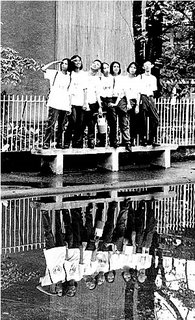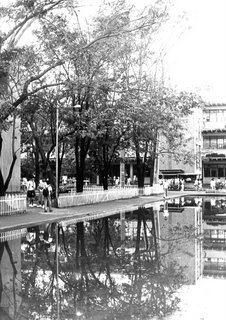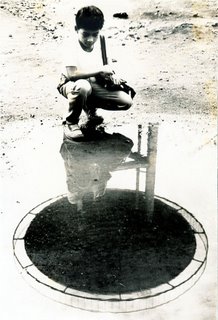Greek mythology tells us the story of Narcissus, a handsome young man, who passed by a river one day. Bending down to drink, he saw his reflection on the surface of the water. Fascinated with how handsome he was, Narcissus fell in love with himself. Psychologists have, therefore, coined the term “narcissism” to refer to a person’s extreme love of self.
Speaking of reflections and extremes, one extremely fine way of expressing your creativity is to shoot objects and/or their reflections on glass, windows, water, etc. Reflections can be used in a variety of ways:
(1) to create abstract designs;
(2) to portray a timeless world of dreams and fantasies; and
(3) to create romantic and nostalgic images (as in the picture below of a high school barkada obviously enjoying each other’s company). Shoot the reflection alone, or shoot the object and its reflection
Shoot the reflection alone, or shoot the object and its reflection
You may choose either to shoot the reflection alone, or both the object and its reflection. When shooting both, you have to use a small aperture or lens opening (more on this topic later) to render both elements sharp. You should also focus on the reflection rather than on the object creating the reflection. Look at the picture above. Since you can’t turn your computer monitor upside down, stand up and then look at this picture with your head upside down. I know it’s a little bit acrobatic but hey it’s worth it! You will know what this picture is all about. The image of the trees, students and building are all repeated as reflections in the water in the foreground area. This is probably the best picture I have ever taken in my life. Hoo-ya!
Look at the picture above. Since you can’t turn your computer monitor upside down, stand up and then look at this picture with your head upside down. I know it’s a little bit acrobatic but hey it’s worth it! You will know what this picture is all about. The image of the trees, students and building are all repeated as reflections in the water in the foreground area. This is probably the best picture I have ever taken in my life. Hoo-ya!
I took the picture shown above way back in October 1989. I’ve noticed previously that every time it rained hard, the front area of the gymnasium of Rizal High School in Pasig would become flooded, and there would be reflections on the water of the trees and that building on the background. I decided that this would make a good subject for a photograph. And so I brought my beloved Canon AE-1 Program SLR camera everyday with me to school, and waited for the rain to come. I brought along my camera every day for one month, and it didn’t rain for one whole month! And so one day, I simply gave up and left my camera at home. Guess what happened? It rained hard that day!
I went home after the lunch break (pizza!), got my camera and loaded it with Negrapan (a black and white film manufactured in Spain). I knew I couldn’t use color film because the water was muddy brown in color; with monochrome film, it didn’t matter. I didn’t have a zoom lens at that time and so I used my Canon FD f/1.8 normal lens. I got back to school at around four in the afternoon. I focused on the reflections, and because it was late afternoon, I was forced to use a slow shutter speed of 1/30 sec. with an f/5.6 lens opening, for the right depth of field. (Later on we’ll discuss shutter speeds, lens openings and depth of field.) In the picture above, I first saw the reflection of the water tank. To provide some human interest, I asked this kid to pose beside the reflection.
In the picture above, I first saw the reflection of the water tank. To provide some human interest, I asked this kid to pose beside the reflection.
Learn from other photographers One way of developing your style is by “imitating” the work of photographers whose work you admire. The picture above is my imitation of Hénri Cartiér Brésson’s famous photograph of a man jumping over a puddle of water. In that classic photograph, the man and his reflection echoed the graceful pose of a dancer in a poster at the left side of the picture. I didn’t have a dancer nor a poster, but I did have a blurry student, ripples on the water, and reflections of the building and students in the background. Yes! Yes! Step aside, Hénri!
One way of developing your style is by “imitating” the work of photographers whose work you admire. The picture above is my imitation of Hénri Cartiér Brésson’s famous photograph of a man jumping over a puddle of water. In that classic photograph, the man and his reflection echoed the graceful pose of a dancer in a poster at the left side of the picture. I didn’t have a dancer nor a poster, but I did have a blurry student, ripples on the water, and reflections of the building and students in the background. Yes! Yes! Step aside, Hénri!
Monday, September 24, 2007
Photojournalism (27): Reflections
Subscribe to:
Comments (Atom)





